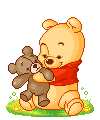Even children who are experiencing attachment strain may have some of these signs of healthy attachment. Knowledge of positive attachment will help parents build on the areas that are strengths, but should not be used to ignore indications—even mild ones--that a baby/child is experiencing difficulty.
1. Joyful the majority of the time.
2. Seeks out primary caregiver for comfort and to meet needs.
3. Likes to be cradled and held facing primary caregiver.
4. Makes good eye contact with primary caregiver and initiates eye contact--both close & distant proximity.
5. When primary caregiver makes eye contact, the child smiles back, showing signs of being happy with the interaction.
6. Smiles and exhibits pleasure when seeing self in the mirror.
7. Frequently engages in playful interactions with primary caregiver (interactions initiated by both parent and child.)
8. Uses different cries to alert primary caregiver of needs and wants; easily consoled by primary caregiver.
9. Accepts limits placed by primary caregiver.
10. Willingly allows primary caregiver to hold bottle, hand feed, and nurture.
11. Melts into primary caregiver when held; lays head on shoulder; holds on when held; faces primary caregiver rather than away.
12. Enjoys cuddling, hugs, and kisses given by primary caregiver and initiates cuddling, hugs, and kisses without wanting something in return.
13, Can co-sleep without major difficulty.
14. Prefers primary caregiver to all others.
15. Imitates primary caregiver regularly (actions, language, etc.)
16. Content to sit on primary caregiver’s lap or stay in primary caregiver’s arms for an age appropriate amount of time.
17, Settles quickly when held by primary caregiver.
18. Enjoys skin on skin contact.
19. Prefers close proximity to primary caregiver but not in an anxious, desperate way.
20. Consistently sleeps well and peacefully.
21. Wants to please primary caregiver because he knows it will make his parent happy.
22. Reacts appropriately to pain; wants primary caregiver to nurture him when in pain or sick; easily consoled.
23. Uses food appropriately. Recognizes when hungry and full.
24. Shows true personality to primary caregiver and family and friends (discovering a child’s innate personality takes time.)
25. Initiates “sweet nothing” talk with primary caregiver.
26. Shows appropriate stranger anxiety.
27. Displays age appropriate anxiety at brief separation from primary caregiver but is able to be reassured.
28. Reunites happily with primary caregiver with eye contact and physical contact.
29. Show signs of feeling safe in social situations; able to play and interact with others, but stays close and checks in with primary caregiver regularly but not in an anxious or desperate way.
30. Is gentle to self and others.
31. Gets along with other children & siblings most of the time.
32. Is okay with primary caregiver leaving the room for short periods of time. Conversely, cares that primary caregiver has left the room and shows happiness when that person returns.
33. Speech/language skills are developing appropriately.
34. Angry outbursts/tantrums are infrequent, short in duration. Parent can soothe child.
35. “Normal” discipline methods/parenting techniques are effective.
36. Child can identify his own feelings (at an age appropriate level.)
37. Child can identify the feelings of others (at an age appropriate level.)
39. Child can delay gratification (at an age appropriate level.) -A4everFamily in consultation with Kali Miller, PhD
Thursday, March 6, 2008
Signs of Healthy Attachment
posted at 1:52 PM
Subscribe to:
Post Comments (Atom)























No comments:
Post a Comment